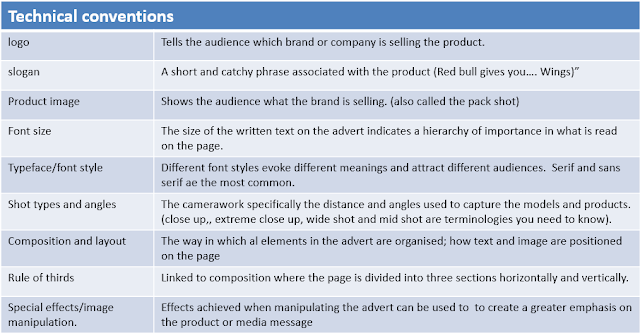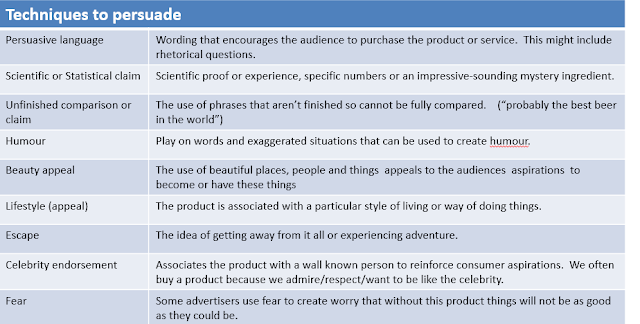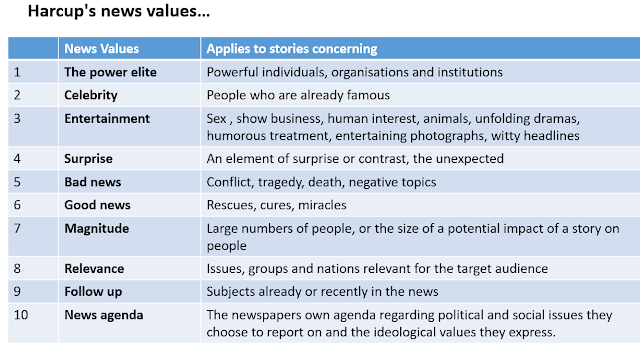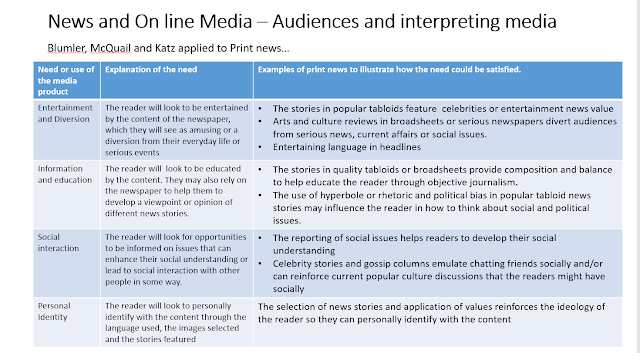Front cover from
kelsiocx
The Daily Mail-
Migrants how many more can we take (2015 August)
Shaming of Facebook - Public interest
Google the terrorist friend
The House Of Fools (Parliament)
Fury over plot to let 1.5m turks into Britain (2016)
Migrant number hit a new record (2016)
The Guardian-
Parliament finally has its no no no no no no no no
Starting gun for Britains badger shoot
He misled the Queen, the people and parliament (sept 2019)
Poultry industries dirty secrets (2014)
Hopes raised for second EU referendum (Jan 2018)
Right wing views ( The Daily Mail) mostly convey the views about going against parliament and having a dislike towards migrants.
Left wing views (The Guardian) are to do with socialism and dont want brexit to happen.
Activity 1 from
kelsiocx
Ownership
refers to who financially supports and produces the paper. Newspaper owners may acquire more than one
brand (consolidation) which helps the owner target different audiences, gaining
a larger market share.
In
the UK there are three different ownership models
1.Media barons –
wealthy owners/proprietors
2.Trusts – a
legal arrangement where the finances from the owner are transferred to a
“trustee” to manage the newspaper
3.Cross media converged
conglomerates (Rupert Murdoch News Corp up until 2018 owned: News UK, 20th Century Fox and part owned Sky)
News and On line Media - Ownership and Control
Task
:
•Identify the political
affiliation/positioning of the Newspaper organisations presented in the above slide
Right
Wing- The Daily Mail, The Sun, The Daily
Express and The Daily Telegraph
Left
Wing- The Mirror, The Independent and The Guardian
•Which two companies own 60% of the
British Press, what is their political affiliation?
The
News UK and DMG Media, Right wing
•Why might Press ownership be important in
shaping the British public views on political issues such as Brexit, voting for
political parties?
Constructive
media makes it nearly impossible for it to be neutral as most of them always
prefer one over the other.
Print media from
kelsiocx
Right wing papers will support conservatives as they have the same views on things as they both come under as right wing, however these types of newspapers will be against left wing or have a negative approach towards the labour party or any other left viewed subject. As you can see from this newspaper above it's going against Jeremy Corbyn leading towards them being anti Corbyn. From the use of the headline it shows what they think of him from saying "Leader who's lost the plot", this is used within competitiors because they want him to look as bad as possible for him to lose and make the newspaper itself be boosted.
£10.79 paper Guardian
£5 Online Guardian
£2 a week Telegraph
£0.70 Daily Mail
British
newspapers must attract audiences to make money and survive.
2015
UK newspaper industry contributed £5.3 Billion Gross value added and supports
£87,500 jobs.
Print
Newspaper production is financed through print sales and advertising revenue.
Circulation
sales
•14.3 million people read a newspaper
every day.
•81% of newspaper revenue comes from
circulation sales.
•The cost of a Daily Newspaper ranges from
3 p to £2.70 with the Daily Mail retailing at xx p and Guardian xx per day (Task
find out what the costs are!)
Advertising
•Advertisers pay for space in the paper
•Advertising in national newspapers is
expensive, depending on the paper’s circulation figures and audience (A, B, C1,
, D, E)
•The cost of a full page colour advert in
the Daily Mail is £30,000
•Newspapers now make money from adverts in
off line (print) and online (digital) editions
•Readers of print newspapers are more
likely to read an advert than online readers.
ALTERNATIVE
METHODS OF FUNDING PRINT NEWS INCLUDE:
Subscriptions
and donations
•Online subscription fees known as
paywalls, which pay for online services and also fund print papers (Task
find out what the subscription costs are for the
telegraph and the Guardian)
•Reader donations and memberships
Planning activity 3 from
kelsiocx
CMYK refers to the four ink plates used in some
color printing: cyan, magenta, yellow, and key (black). The
CMYK model works by partially or entirely masking
colors on a lighter, usually white, background. The ink reduces the light that would otherwise be reflected.
https://www.google.co.uk/url?sa=t&rct=j&q=&esrc=s&source=web&cd=1&cad=rja&uact=8&ved=2ahUKEwiM17yOqdjlAhVGasAKHaiZDFMQFjAAegQIARAB&url=https%3A%2F%2Fwww.instagram.com%2Fguardian%2F%3Fhl%3Den&usg=AOvVaw00dRTUM2oSY7zl-3lMoTov
The Guardian Instagram
Technological from
kelsiocx
Over
the past 20 years, since the introduction of web2.0 in 2004 the print industry has undergone significant
changes in production, distribution and circulation.•To remain relevant for audiences and
tackling falling sales of print copies, newspapers have expanded their copies
online. This has a number of advantages
online for owners:
•Production via websites reduces
environmental costs of producing with paper and ink.
•Distribution via the internet reduces the
cost of physical distribution and enables news outlets to reach a global
audience.
•Circulation via websites and mobile
devices allows audiences to access news and advertising online through apps and
social media.
This
increases circulation numbers for the news outlet -
More people see it and read it
Allows
audiences to share and interact with the news
Enables
owners to monitor which stories are most popular
Soft news-Soft news is defined as information that is primarily entertaining or personally useful. Soft news is often compared to hard news, which John Zaller defines as the "coverage of breaking events involving top leaders, major issues, or significant disruptions in the routines of daily life."
Hard News- Hard new generally refers to up-to-the-minute news and events that are reported immediately, while soft news is background information or human-interest stories. Politics, war, economics and crime used to be considered hard news, while arts, entertainment and lifestyles were considered soft news.
Cultivation theory- suggests that exposure to media,over time, subtly 'cultivates' viewers perceptions of reality. Gerbner and Gross assert 'Television is a medium of the socialization of most people into standardized roles and behaviours. Its function is in a word, enculturation'.
Owners of the
Guardian- Guardian Media Group- Scott Trust Limited- Katharine Viner
Telegraph-Barclay Brothers- Chris EvansThe Sun-
Left-wing politics
supports social equality and egalitarianism, often in opposition to social hierarchy. It typically involves a
concern for those in society whom its adherents perceive as disadvantaged
relative to others as well as a belief that there are unjustified inequalities
that need to be reduced or abolished.
Right-wing political thinking holds that certain social orders and hierarchies are inevitable, natural,
normal, or desirable
Capitalism is an economic system based on the private ownership of the means of production and their operation for profit. Characteristics central to capitalism include private property, capital accumulation, wage labor, voluntary exchange, a price system and competitive markets.
Socialism is a range of economic and social systems characterised by social ownership of the means of production and workers' self-management, as well as the political theories and movements associated with them. Social ownership can be public, collective or cooperative ownership, or citizen ownership of equity.
Arguments
for and against the regulation of the news revolve around two opposing views:
•For:
the News Industry has too much political power nd influence over the British public, which
has reduced freedom of speech, compromises democracy and is not in the public
interest.
•Against:
The printed press should not be regulated or controlled, especially not by
government legislation. This would
effect freedom of speech, democracy and would not be in the pubic interest.
Regulation
of the UK News industry focuses on:
•News
content and information printed by the Press
•Ownership
and competition laws
IPSO-
holds newspapers to account
protects the rights of the individual
upholds standards of journalism
mantains freedom of expression for the press
Slides from
kelsiocx
The term cockroaches which Katie linked to migrants is a term from the nazis about the jews, so even though she is calling them cockroaches it is taking another approach to being disrespectful, this would lead to discrimination within this article.
The Guardian-
Economic
models and funding
Historically,
The Guardian first received financial support from middle class radicals. Until
recently the traditional newspaper model of acquiring revenue from circulation
sales and advertising has been the main source of funding.
Circulation
•The Guardian has a share of just 2.8% of
the UK print news market.
•(Nov 2018) The paper had a weekly circulation of 986,872
•Previous studies should show that there
is a decline imn
revenue from print sales
Advertising
•The colour advertising rate is £90 per
column centimetre
•The cheapest advert measures 8 x 7 cm =
£5000
•A double page spread is £32,400
Note
with declining circulation figures the Guardian will become less attractive to
advertisers.
Alternative
revenue options and solutions
1
Donations
More
than 800,00 readers fund the Guardian:
•570,00 regular supporters
•375,00 one-off contributions
2
The Scott Trust
The
Trust focusses on socially responsible investment and all profit from these
investments supports GMG
The
Trust set up theguardian.org a
non profit organisation that raises funds from groups or private donors
3
Philanthropic contributions
These
come from wealthy donors such as Bill gates (former Microsoft owner)
4 Reducing production Costs
•In 2018 the size format of the paper
changed from a Berliner (European format) to a a tabloid.
•The reduction in size format saved the
newspaper £19 million
•The cover price for the newspaper was
increased to £2.00 in 2016 and £2.20 in 2019.
The
Guardian has had a long association with serious quality journalism, its social
roots (Manchester) have also lead it to
highlight the arts and culture for the public good. The news values of the paper reflect the
lives of the public from al cultures and walks of life.
The
Guardians current editor Katharine Viner
prioritises stories that are in the publics interest and for the common
good, and if they effect equality and freedom.
Journalists
need to report on all forms of public life including different cultures,
diverse perspectives and community services.
This comes under public interest because it has to do with everone and it affects everyone who is under that specific catergory or that certain party.
It is showing a negative perspective on the concern and relating it to everyone reading or that is involved.
As The Sun is right wing the front cover has a negative impact on the look of Jeremy Corbyn. The Sun's target audience is.
Who Is the Target Audience of The Guardian Newspaper? The Guardian newspaper targets a well-educated, relatively young, predominantly male and liberal audience centered around London. Fifty-two percent of Guardian readers are male, and the average reader age is 44.
Liberal Democrats
Left Wing
Newspapers
must appeal to audiences and advertisers to stay profitable. They do his through the content they offer to
their audiences.
News
Stories selected .
The
stories featured in a paper reflect the viewpoint of the owner and editor of
the paper, they must also reinforce the
values and interest of the target audience
Harcup’s
news values (2001) address the importance and appeal of sensationalism and
attracting audiences
How
do Newspapers target and reach their audiences? (further detail on page 33 OCR
notes).
•
1. Price.
•Set to appeal to the audiences socio
demographic profile
•A redtop tabloid costs between 40 p
and75p, a broadsheet newspaper ranges from £1.60 - £2.70
2.Cross platform advertising
3.Promotional offers
•Offers such as free give away’s,
posters, discounts on holidays shopping vouchers appeal to and reach the target
audience
4.Subscriptions
5.Sponsorship
6.Partnership marketing
Daily Mail-
Gender- Women
Age- 55+
Class-C1C2
Region- London
The Guardian-
Gender- Men
Age- 55+
Class-AB
Region- London



It shows the Queen's reaction to all thats happened this year with Philips car crash in January, the rugby player in August, Meghans breakdown in October and the ordeals with Prince Andrew and the scandal. It shows the difference between the good news and the bad news considering that they put an advertisement for a holiday in the french alps above the bad news. The relevance is the royal family because the public want to know whats happening with them and it puts a bad reputation onto them making it seem not all luxury and happiness. The celebrities are of course the royal family as it links to all of them as a family.
#
Harcup’s values represented in this
newspaper shows a different meaning from good news to bad news with the bad
news being the main storyline of this article as there is hardly any good news.
The celebrity is the royal family with the prince being included, the relevance
is the NHS as it all relates to everyone in the United Kingdom because it is
relied on by everyone. The power elite in this newspaper is the US government as they are an powerful organisation. This is a more professional and serious article relating to the news at hand keeping it respectful. There isn't much of a surprise either to go with the entertainment factor. The magnitude is the NHS and for the people in America and Israel as it will have the most impact on them people who relate to that.





































